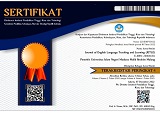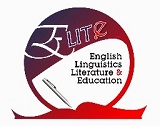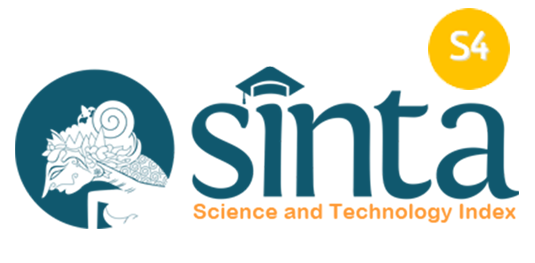Students’ perception on the use of the Duolingo application as a medium for developing university-level English language skills
Abstract
Keywords
Full Text:
PDFReferences
Afrianto, A. (2018). Being a professional teacher in the era of industrial revolution 4.0: Opportunities, challenges and strategies for innovative classroom practices. English Language Teaching and Research, 2(1), Article 1. https://ejournal.unp.ac.id/index.php/eltar/article/view/102675
Aulia, H. R., Wahjuningsih, E., & Andayani, R. (2020). Effect of Duolingo Application on students’ English vocabulary mastery. ELTR Journal, 4(2), 131–139. https://doi.org/10.37147/eltr.v4i2.71
Ceci, L. (2023). Number of Duolingo app downloads worldwide from 1st quarter 2017 to 3rd quarter 2023, by region. Statista. https://www.statista.com/statistics/1239391/duolingo-number-of-worldwide-downloads-by-region/
García Botero, G., & Questier, F. (2016). What students think and what they actually do in a mobile assisted language learning context: New insights for self-directed language learning in higher education. In S. Papadima-Sophocleous, L. Bradley, & S. Thouësny (Eds.), CALL communities and culture – short papers from EUROCALL 2016 (pp. 150–154). Research-publishing.net. https://doi.org/10.14705/rpnet.2016.eurocall2016.553
Herdianto, R., & Syahidin, D. (2020). Gadget & adolescent: Its effect depiction on the daily life. Bulletin of Social Informatics Theory and Application, 4(2), 40–51. https://doi.org/10.31763/businta.v4i2.266
Hidayati, T., & Diana, S. (2022). Students’ motivation to learn English using mobile applications: The case of Duolingo and Hello English. JEELS (Journal of English Education and Linguistics Studies), 6(2), 189–213. https://doi.org/10.30762/jeels.v6i2.1233
Inayah, N., Yusuf, Q., & Fibula, N. (2020). Exploring undergraduate students’ perception toward the use of Duolingo in learning English. Humanities & Social Sciences Reviews, 8(3), 76–85. https://doi.org/10.18510/hssr.2020.839
Mills, G., & Gay, L. (2016). Education research: Competencies for analysis and applications. Journal of Applied Learning & Teaching, 1(2), 71–72. https://doi.org/10.37074/jalt.2018.1.2.14
Nushi, M., & Eqbali, M. H. (2017). Duolingo: A mobile application to assist second language learning. Teaching English with Technology, 17(1), 89–98.
Pratiwi, T. M. S., Chandra, N. E., & Arapah, E. (2023). Exploring students’ perception on the use of Instagram as a platform in Creative Writing course. Journal of English Language Teaching and Learning (JETLE), 4(2), Article 2. https://doi.org/10.18860/jetle.v4i2.20675
Redjeki, I. S., & Muhajir, R. (2020). Duolingo for grammar learning. Prosiding LPPM UIKA Bogor. https://pkm.uika-bogor.ac.id/index.php/prosiding/article/view/659
Redjeki, I. S., & Muhajir, R. (2021). Gamification in EFL classroom to support teaching and learning in 21st century. JEES (Journal of English Educators Society), 6(1), 68–78. https://doi.org/10.21070/jees.v6i1.882
Rohmana, W. I. M. (2022). The use of Livemocha: A platform for independent language learning. Abjadia : International Journal of Education, 7(1), Article 1. https://doi.org/10.18860/abj.v7i1.15234
Shortt, M., Tilak, S., Kuznetcova, I., Martens, B., & Akinkuolie, B. (2023). Gamification in mobile-assisted language learning: A systematic review of Duolingo literature from public release of 2012 to early 2020. Computer Assisted Language Learning, 36(3), 517–554. https://doi.org/10.1080/09588221.2021.1933540
Sugiyono, S. (2014). Metode Penelitian Kuantitatif, Kualitatif dan R & D. Alfabeta.
Yang, S. (2012). Exploring college students’ attitudes and self-efficacy of mobile learning. Turkish Online Journal of Educational Technology - TOJET, 11(4), 148–154.
DOI: https://doi.org/10.18860/jetle.v5i2.23667
Refbacks
- There are currently no refbacks.
Jalan Gajayana 50 Malang 65144, Jawa Timur, Indonesia

This work is licensed under a Creative Commons Attribution-ShareAlike 4.0 International License.
Indexed by





